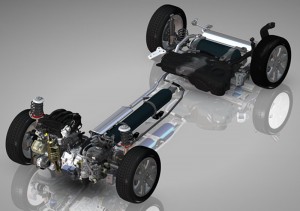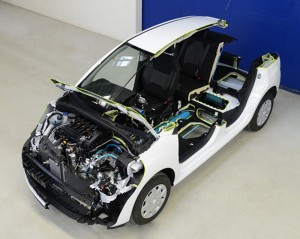
Increasingly ambitious standards are being set worldwide to reduce emissions of greenhouse gasses and pollutants (NOx and particulates), with targets of 95g of CO2 per km in Europe and 117g per km in China by 2020. Full-Hybrid vehicles will be a necessary part of the equation to meet the 2020 CAFE targets, even though the vast majority of automobiles will still be powered by internal combustion engines. Hybrids could well represent some 15% of a European market heavily dominated by Asian carmakers.
Backed by its experience in hybrid technology, PSA Peugeot Citroën intends to enhance its environmental leadership in the area of low-carbon mobility, while meeting customers’ needs and expectations concerning costs and features.
Hybrid Air is a new type of full-hybrid powertrain that combines a petrol engine and compressed air for energy storage instead of a battery, offering an alternative to electric hybrid solutions. Hybrid Air positions PSA Peugeot Citroën as the global leader in this technology, with an affordable core model offering that delivers lower fuel consumption and ease of use.
With a CO2/price trade-off unmatched by any of the current hybrid technologies, hybrid air represents a real breakthrough.
Hybrid Air technology offers multiple advantages for the customer:
- Affordability. This innovation will make it possible to offer an attractive hybrid range, with broad coverage of all passenger car and light commercial vehicle segments both in and outside Europe. It will be featured on B segment (82 hp petrol engine) and C segment (110 hp petrol engine) models, as well as light commercial vehicles.
- Low fuel consumption and a significantly reduced environmental footprint thanks to fuel savings of 45% in city driving that translate into a 90% increase in driving range compared with conventional engines with the same power rating. Certified fuel consumption stands at 2.9l/100km in combined-cycle driving, for CO2 emissions of around 69g/km for standard body style models such as the Citroën C3 or Peugeot 208. In comparison, PSA Peugeot Citroën’s 3-cylinder petrol engines with manual gearshift produce 104g of CO2 per km in combined-cycle driving. Vehicles equipped with Hybrid Air technology can also run on Air Power alone (with no CO2 emissions) 60 to 80% of the time in city driving, depending on traffic density, thanks to the optimal efficiency of energy recovery during braking. Lastly, the materials used in Hybrid Air technology are both plentiful and easily recyclable, for a lower environmental impact.
-
A spacious interior, allowing for modular passenger compartment design without surrendering boot volume.
- Uncompromising driving comfort and road handling. Hybrid Air delivers perceptible driving sensations, such as nimble response with the boost effect, as well as first-class road handling thanks to an automatic transmission without torque interruption.
-
Worldwide viability. Hybrid Air technology is viable in all markets, making it possible to offer energy efficient automobiles in all types of climates and regardless of the extent of the maintenance network. In addition, Hybrid Air technology can be industrialised in numerous high-growth international markets.

Hybrid Air is an innovative combination of tested technologies, with a petrol engine, a compressed air energy storage unit, a hydraulic pump/motor unit and an automatic transmission. An intelligent electronic management system adapts the operating mode to the user’s driving style and optimises energy efficiency. The hydraulic components (motor and pump) recover and store the energy generated by:
- The internal combustion engine operating at top efficiency.
- Braking and deceleration (kinetic energy).
A specific continuous transmission ensures optimal use of the different energy sources depending on the type of driving in three operating modes:
- Petrol power, with the petrol engine as the sole source of propulsion.
- Air power, with the hydraulic motor alone transmitting energy to the wheels via the accumulators.
- Combined power, with the internal combustion engine and hydraulic motor working together.
PSA Peugeot Citroën has filed more than 80 patents around the world for this technology.
Source; PSA (Peugeot Citroen)
